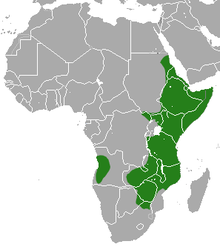Heterohyrax brucei
| Yellow-spotted rock hyrax | |
|---|---|
 |
|
| Scientific classification | |
| Kingdom: | Animalia |
| Phylum: | Chordata |
| Class: | Mammalia |
| Order: | Hyracoidea |
| Family: | Procaviidae |
| Genus: |
Heterohyrax Gray, 1868 |
| Species: | H. brucei |
| Binomial name | |
|
Heterohyrax brucei (Gray, 1868) |
|
| Subspecies | |
|
25, see text |
|
 |
|
| Yellow-spotted rock hyrax range | |
25, see text
Heterohyrax brucei, more commonly known as the yellow-spotted rock hyrax or bush hyrax, is a species of mammal in the family Procaviidae. It is found in Angola, Botswana, Burundi, Democratic Republic of the Congo, Southern Egypt, Eritrea, Ethiopia, Kenya, Malawi, Mozambique, Rwanda, Somalia, Northern South Africa, Sudan, Tanzania, Uganda, Zambia, and Zimbabwe. Its natural habitats are dry savanna and rocky areas. Hyrax comes from the Greek word ὕραξ, or shrew-mouse.
Heterohyrax is a bush hyrax, as opposed to a rock hyrax (Procavia capensis) or a tree hyrax (Dendrohyrax). Although difficult to distinguish in the field, the bush hyrax differs from the rock hyrax in being smaller and less heavily built and having a narrower muzzle. Hyraxes have molariform teeth that are brachydont, meaning they have short crowns and well-developed roots. The bush hyrax has an upper premolar series that is the same length as the molar series, while the rock hyrax has a shorter upper premolar series and the tree hyrax has a longer upper premolar series. Hyraxes have upper tusk-like upper incisors and four lower incisors that are comb-like and used to groom the fur. While the incisors do not differentiate between the hyraxes, they do differ between sexes. Males have rigid upper incisors while the females have rounded upper incisors. Furthermore, the male sex organs also differ greatly between these three genera of hyraxes which may inhibit them from interbreeding.
...
Wikipedia

